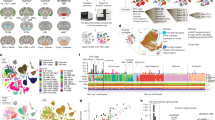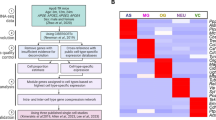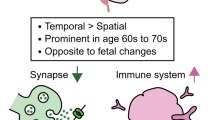Abstract
Ageing of the brain leads to impairments in cognitive and motor skills, and is the major risk factor for several common neurological disorders such as Alzheimer disease (AD) and Parkinson disease (PD). Recent studies suggest that normal brain ageing is associated with subtle morphological and functional alterations in specific neuronal circuits, as opposed to large-scale neuronal loss1. In fact, ageing of the central nervous system in diverse mammalian species shares many features, such as atrophy of pyramidal neurons, synaptic atrophy, decrease of striatal dopamine receptors, accumulation of fluorescent pigments, cytoskeletal abnormalities, and reactive astrocytes and microglia2. To provide the first global analysis of brain ageing at the molecular level, we used oligonucleotide arrays representing 6,347 genes to determine the gene-expression profile of the ageing neocortex and cerebellum in mice. Ageing resulted in a gene-expression profile indicative of an inflammatory response, oxidative stress and reduced neurotrophic support in both brain regions. At the transcriptional level, brain ageing in mice displays parallels with human neurodegenerative disorders. Caloric restriction, which retards the ageing process in mammals, selectively attenuated the age-associated induction of genes encoding inflammatory and stress responses.
This is a preview of subscription content, access via your institution
Access options
Subscribe to this journal
Receive 12 print issues and online access
We are sorry, but there is no personal subscription option available for your country.
Buy this article
- Purchase on SpringerLink
- Instant access to full article PDF
Prices may be subject to local taxes which are calculated during checkout

Similar content being viewed by others
References
Morrison, J.H. & Hof, P.R. Life and death of neurons in the aging brain. Science 278, 412–419 (1997).
Finch, C.E. & Roth, G.S. in Basic Neurochemistry (eds Seigel, G., Agranoff, J.B., Albers, W.R.W., Fisher, S.K. & Uhler, M.D.) 613–633 (Lippincott-Raven, Philadelphia, 1999).
Gaubatz, J.W. in Molecular Basis of Aging (ed. Macieira-Coelho, A.) 71–182 (CRC Press, Boca Raton, 1995).
McEwen, B.S. Stress and the aging hippocampus. Front. Neuroendocrinol. 20, 49–70 (1998).
Sohal, R.S. & Weindruch, R. Oxidative stress, caloric restriction, and aging. Science 273, 59–63 (1996).
Disterhoft, J.F., Gispen, W.H., Traber, J. & Khachaturian, Z.F. Calcium Hypothesis of Aging and Dementia (New York Academy of Sciences Press, New York, 1994).
Blumenthal, H.T. Fidelity assurance mechanisms of the brain with special reference to its immunogenic CNS compartment: their role in aging and aging-associated neurological disease. J. Gerontol. Biol. Sci. Med. Sci. 52, B1–B9 (1997).
Weindruch, R. & Walford, R.L. The Retardation of Aging and Disease by Dietary Restriction (C.C. Thomas, Springfield, Illinois, 1988).
Ingram, D.K., Weindruch, R., Spangler, E.L., Freeman, J.R. & Walford, R.L. Dietary restriction benefits learning and motor performance of aged mice. J. Gerontol. 42, 78–81 (1987).
Moroi-Fetters, S.E., Mervis, R.F., London, E.D. & Ingram, D.K. Dietary restriction suppresses age-related changes in dendritic spines. Neurobiol. Aging 10, 317–322 (1989).
Duan, W. & Mattson, M.P. Dietary restriction and 2-deoxyglucose administration improve behavioral outcome and reduce degeneration of dopaminergic neurons in models of Parkinson's disease. J. Neurosci. Res. 57, 195–206 (1999).
Suo, Z. et al. Alzheimer's β-amyloid peptides induce inflammatory cascade in human vascular cells: the roles of cytokines and CD40. Brain Res. 807, 110–117 (1998).
Hallgren, R., Terent, A. & Venge, P. Lactoferrin, lysozyme, and β 2-microglobulin levels in cerebrospinal fluid: differential indices of CNS inflammation. Inflammation 6, 291–304 (1982).
Huang, J. et al. Neuronal protection in stroke by an sLex-glycosylated complement inhibitory protein. Science 285, 595–599 (1999).
Pasinetti, G.M., Hassler, M., Stone, D. & Finch, C.E. Glial gene expression during aging in rat striatum and in long-term responses to 6-OHDA lesions. Synapse 31, 278–284 (1999).
Lemere, C.A. et al. The lysosomal cysteine protease, cathepsin S, is increased in Alzheimer's disease and Down syndrome brain. An immunocytochemical study. Am. J. Pathol. 146, 848–860 (1995).
Hermann, D.M., Mies, G. & Hossmann, K.A. Expression of c-Fos, JunB, c-Jun, MKP-1 and HSP72 following traumatic neocortical lesions in rats—relation to spreading depression. Neuroscience 88, 599–608 (1999).
Nichols, N.R., Day, J.R., Laping, N.J., Johnson, S.A. & Finch, C.E. GFAP mRNA increases with age in rat and human brain. Neurobiol. Aging 14, 421–429 (1993).
Fox, J.W. et al. Mutations in filamin 1 prevent migration of cerebral cortical neurons in human periventricular heterotopia. Neuron 21, 1315–1325 (1998).
Mattson, M.P. et al. Cellular signaling roles of TGF β, TNFα and β APP in brain injury responses and Alzheimer's disease. Brain Res. Rev. 23, 47–61 (1997).
Kaltschmidt, B., Sparna, T. & Kaltschmidt, C. Activation of NF—B by reactive oxygen intermediates in the nervous system. Antioxidants Redox Signalling 1, 129–144 (1999).
Ryseck, R.P., Weih, F., Carrasco, D. & Bravo, R. RELB, a member of the REL/NF—B family of transcription factors. Braz. J. Med. Biol. Res. 29, 895–903 (1996).
Rogers, J. et al. Inflammation and Alzheimer's disease pathogenesis. Neurobiol. Aging 17, 681–686 (1996).
Lee, C.-K., Klopp, R.G, Weindruch, R. & Prolla, T.A. Gene expression profile of aging and its retardation by caloric restriction. Science 285, 1390–1393 (1999).
Heid, C.A., Stevens, J., Livak, K.J. & Williams, P.M. Real time quantitative PCR. Genome Res. 6, 986–994 (1996).
Lipshutz, R.J., Fodor, S.P., Gingeras, T.R. & Lockhart, D.J. High density synthetic oligonucleotide arrays. Nature Genet. 21, 20–24 (1999).
Acknowledgements
This work was supported by NIH grants P01 AG11915 (R.W.) and R01 CA 78723 (T.A.P.). T.A.P. is a recipient of the Shaw Scientist (Milwaukee Foundation), Burroughs Wellcome Young Investigator and Basil O'Connor (March of Dimes) awards.
Author information
Authors and Affiliations
Corresponding authors
Rights and permissions
About this article
Cite this article
Lee, CK., Weindruch, R. & Prolla, T. Gene-expression profile of the ageing brain in mice. Nat Genet 25, 294–297 (2000). https://doi.org/10.1038/77046
Received:
Accepted:
Issue Date:
DOI: https://doi.org/10.1038/77046



